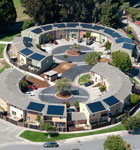Though EAH Housing applies sustainable practices at its communities throughout California and Hawaii, the showstopper is Crescent Park, the largest solar-powered affordable housing community in the country and a property that eliminates the need for nearly 14,000 tons of carbon over the course of its life. Dave Egan, EAH’s project manager, discusses what makes this property so remarkable.
What made you decide to utilize solar power on the Crescent Park project?
Dave Egan: When we acquired Crescent Park, EAH already had the notion of performing a major rehab on the property. Through … low-income housing tax credits, federal solar-energy tax credits, and additional financing through the California Solar Initiative program, we were able to carry out the long-planned property rehabilitation, [as well as] our ambitious solar retrofit plans for the property.
What makes this solar-powered community unique?
Egan: First and foremost is the photovoltaic solar system that we were able to install. Photovoltaic panels were distributed … over a variety of roofs styles within the property. Of the 26 buildings with solar panels, over half of the buildings have crescent-shaped buildings with sloped roofs, making it difficult to place the panel systems efficiently on those buildings. As a result, each crescent-shaped building had a unique solar panel layout.
This solar power project also serves the surrounding community by helping the City of Richmond meet its clean energy goals. The Crescent Park solar panels account for 20 percent of the City of Richmond’s goal to [derive] five megawatts of power from solar energy.
How many solar panels are within the Crescent Park community?
Egan: It is a very large system, consisting of 4,285 solar panels spread out over the roofs of 26 of the property’s 28 buildings.
How much energy does this solar system provide?
Egan: The system is designed to absorb about 70 percent of the electric usage within the property in any given year. It was a significant benefit to the bottom line of the property and our ability to redirect funds that would have gone directly to the utility under the operating platform and go into other ongoing resident services, programs, and continuing maintenance of the property.
As far as the annual production, it was projected to produce over one million kilowatt-hours per year. That translates to avoiding 26,044 tons of coal or 4,037,290 gallons of oil over a 30-year period. Avoided emissions … would be nearly 14,000 tons of carbon dioxide.


